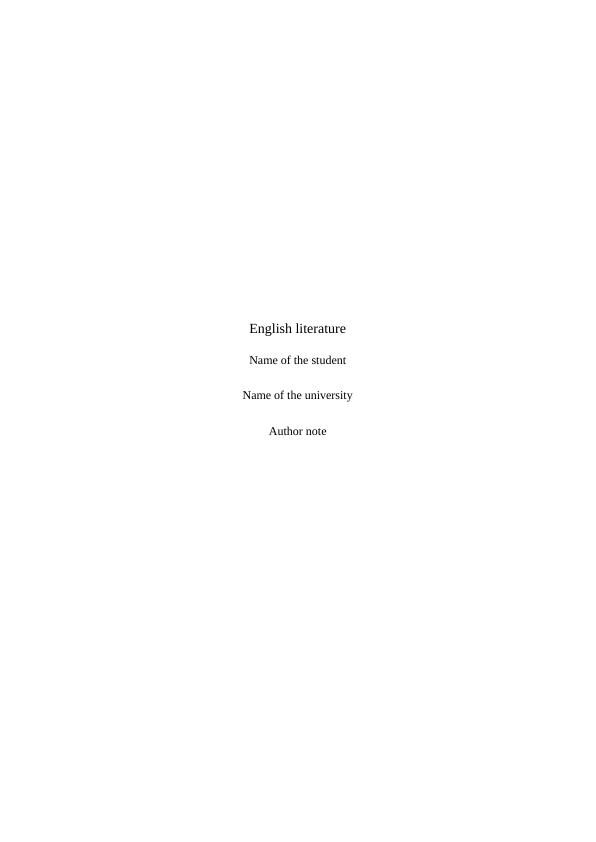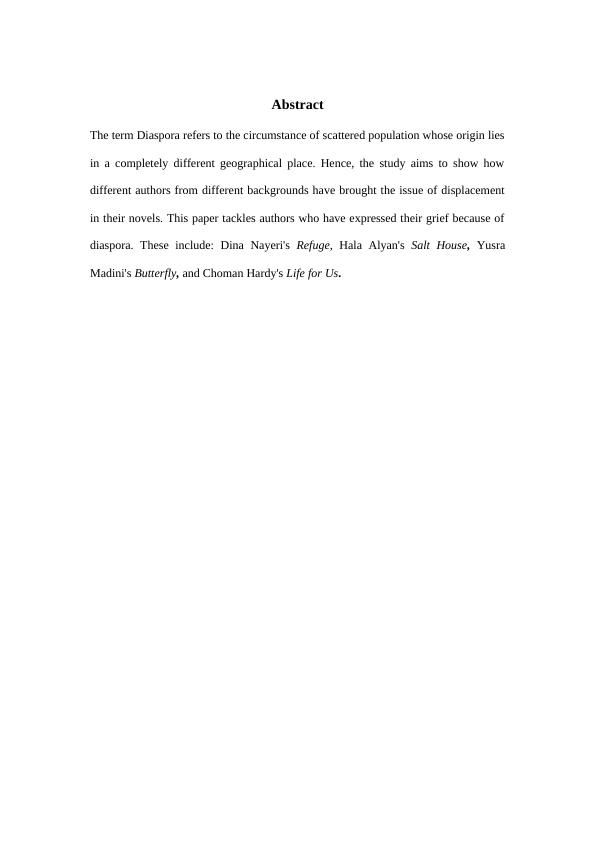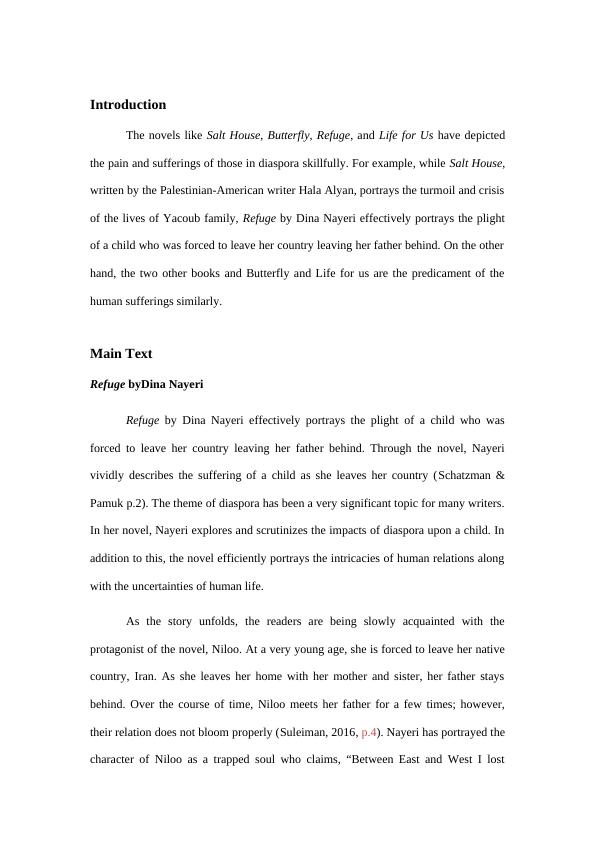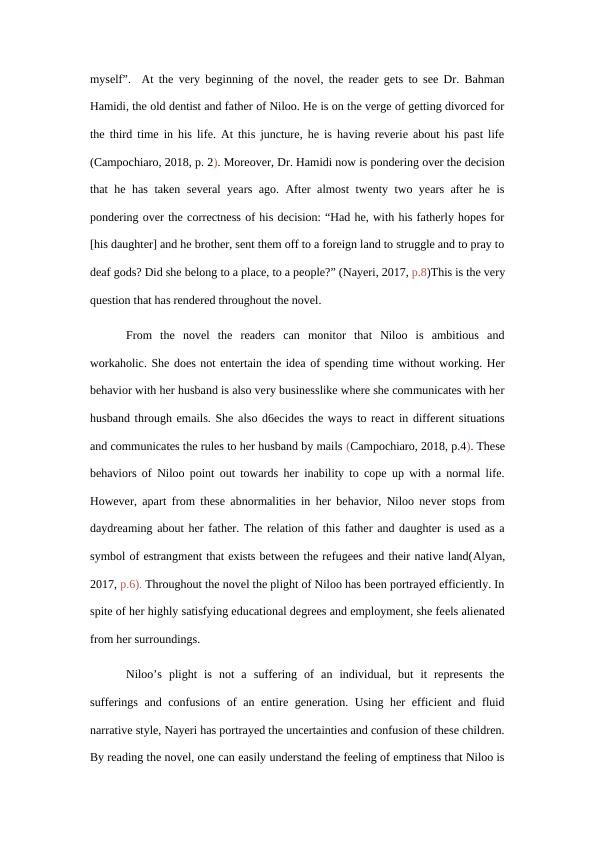Diaspora in Novels: A Study of Displacement in Refuge, Salt House, Butterfly, and Life for Us
Added on 2023-06-01
13 Pages3645 Words207 Views
English literature
Name of the student
Name of the university
Author note
Name of the student
Name of the university
Author note

Abstract
The term Diaspora refers to the circumstance of scattered population whose origin lies
in a completely different geographical place. Hence, the study aims to show how
different authors from different backgrounds have brought the issue of displacement
in their novels. This paper tackles authors who have expressed their grief because of
diaspora. These include: Dina Nayeri's Refuge, Hala Alyan's Salt House, Yusra
Madini's Butterfly, and Choman Hardy's Life for Us.
The term Diaspora refers to the circumstance of scattered population whose origin lies
in a completely different geographical place. Hence, the study aims to show how
different authors from different backgrounds have brought the issue of displacement
in their novels. This paper tackles authors who have expressed their grief because of
diaspora. These include: Dina Nayeri's Refuge, Hala Alyan's Salt House, Yusra
Madini's Butterfly, and Choman Hardy's Life for Us.

Introduction
The novels like Salt House, Butterfly, Refuge, and Life for Us have depicted
the pain and sufferings of those in diaspora skillfully. For example, while Salt House,
written by the Palestinian-American writer Hala Alyan, portrays the turmoil and crisis
of the lives of Yacoub family, Refuge by Dina Nayeri effectively portrays the plight
of a child who was forced to leave her country leaving her father behind. On the other
hand, the two other books and Butterfly and Life for us are the predicament of the
human sufferings similarly.
Main Text
Refuge byDina Nayeri
Refuge by Dina Nayeri effectively portrays the plight of a child who was
forced to leave her country leaving her father behind. Through the novel, Nayeri
vividly describes the suffering of a child as she leaves her country (Schatzman &
Pamuk p.2). The theme of diaspora has been a very significant topic for many writers.
In her novel, Nayeri explores and scrutinizes the impacts of diaspora upon a child. In
addition to this, the novel efficiently portrays the intricacies of human relations along
with the uncertainties of human life.
As the story unfolds, the readers are being slowly acquainted with the
protagonist of the novel, Niloo. At a very young age, she is forced to leave her native
country, Iran. As she leaves her home with her mother and sister, her father stays
behind. Over the course of time, Niloo meets her father for a few times; however,
their relation does not bloom properly (Suleiman, 2016, p.4). Nayeri has portrayed the
character of Niloo as a trapped soul who claims, “Between East and West I lost
The novels like Salt House, Butterfly, Refuge, and Life for Us have depicted
the pain and sufferings of those in diaspora skillfully. For example, while Salt House,
written by the Palestinian-American writer Hala Alyan, portrays the turmoil and crisis
of the lives of Yacoub family, Refuge by Dina Nayeri effectively portrays the plight
of a child who was forced to leave her country leaving her father behind. On the other
hand, the two other books and Butterfly and Life for us are the predicament of the
human sufferings similarly.
Main Text
Refuge byDina Nayeri
Refuge by Dina Nayeri effectively portrays the plight of a child who was
forced to leave her country leaving her father behind. Through the novel, Nayeri
vividly describes the suffering of a child as she leaves her country (Schatzman &
Pamuk p.2). The theme of diaspora has been a very significant topic for many writers.
In her novel, Nayeri explores and scrutinizes the impacts of diaspora upon a child. In
addition to this, the novel efficiently portrays the intricacies of human relations along
with the uncertainties of human life.
As the story unfolds, the readers are being slowly acquainted with the
protagonist of the novel, Niloo. At a very young age, she is forced to leave her native
country, Iran. As she leaves her home with her mother and sister, her father stays
behind. Over the course of time, Niloo meets her father for a few times; however,
their relation does not bloom properly (Suleiman, 2016, p.4). Nayeri has portrayed the
character of Niloo as a trapped soul who claims, “Between East and West I lost

myself”. At the very beginning of the novel, the reader gets to see Dr. Bahman
Hamidi, the old dentist and father of Niloo. He is on the verge of getting divorced for
the third time in his life. At this juncture, he is having reverie about his past life
(Campochiaro, 2018, p. 2). Moreover, Dr. Hamidi now is pondering over the decision
that he has taken several years ago. After almost twenty two years after he is
pondering over the correctness of his decision: “Had he, with his fatherly hopes for
[his daughter] and he brother, sent them off to a foreign land to struggle and to pray to
deaf gods? Did she belong to a place, to a people?” (Nayeri, 2017, p.8)This is the very
question that has rendered throughout the novel.
From the novel the readers can monitor that Niloo is ambitious and
workaholic. She does not entertain the idea of spending time without working. Her
behavior with her husband is also very businesslike where she communicates with her
husband through emails. She also d6ecides the ways to react in different situations
and communicates the rules to her husband by mails (Campochiaro, 2018, p.4). These
behaviors of Niloo point out towards her inability to cope up with a normal life.
However, apart from these abnormalities in her behavior, Niloo never stops from
daydreaming about her father. The relation of this father and daughter is used as a
symbol of estrangment that exists between the refugees and their native land(Alyan,
2017, p.6). Throughout the novel the plight of Niloo has been portrayed efficiently. In
spite of her highly satisfying educational degrees and employment, she feels alienated
from her surroundings.
Niloo’s plight is not a suffering of an individual, but it represents the
sufferings and confusions of an entire generation. Using her efficient and fluid
narrative style, Nayeri has portrayed the uncertainties and confusion of these children.
By reading the novel, one can easily understand the feeling of emptiness that Niloo is
Hamidi, the old dentist and father of Niloo. He is on the verge of getting divorced for
the third time in his life. At this juncture, he is having reverie about his past life
(Campochiaro, 2018, p. 2). Moreover, Dr. Hamidi now is pondering over the decision
that he has taken several years ago. After almost twenty two years after he is
pondering over the correctness of his decision: “Had he, with his fatherly hopes for
[his daughter] and he brother, sent them off to a foreign land to struggle and to pray to
deaf gods? Did she belong to a place, to a people?” (Nayeri, 2017, p.8)This is the very
question that has rendered throughout the novel.
From the novel the readers can monitor that Niloo is ambitious and
workaholic. She does not entertain the idea of spending time without working. Her
behavior with her husband is also very businesslike where she communicates with her
husband through emails. She also d6ecides the ways to react in different situations
and communicates the rules to her husband by mails (Campochiaro, 2018, p.4). These
behaviors of Niloo point out towards her inability to cope up with a normal life.
However, apart from these abnormalities in her behavior, Niloo never stops from
daydreaming about her father. The relation of this father and daughter is used as a
symbol of estrangment that exists between the refugees and their native land(Alyan,
2017, p.6). Throughout the novel the plight of Niloo has been portrayed efficiently. In
spite of her highly satisfying educational degrees and employment, she feels alienated
from her surroundings.
Niloo’s plight is not a suffering of an individual, but it represents the
sufferings and confusions of an entire generation. Using her efficient and fluid
narrative style, Nayeri has portrayed the uncertainties and confusion of these children.
By reading the novel, one can easily understand the feeling of emptiness that Niloo is

End of preview
Want to access all the pages? Upload your documents or become a member.